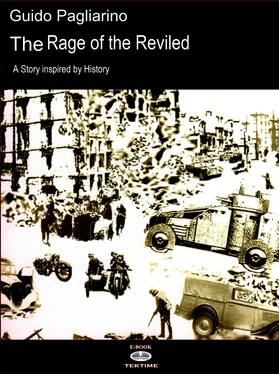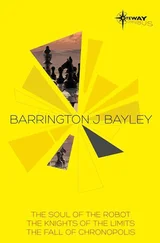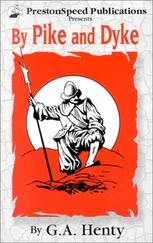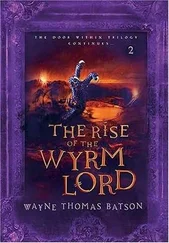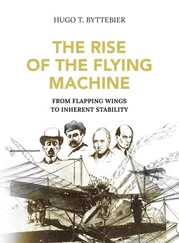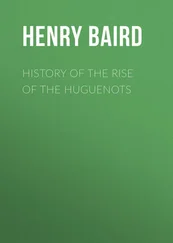"I knew that the baker had recognized the real culprit in the street and had reported it to one of our patrols, who had stopped him and brought him here."
"Yes, and the dead man’s mother had been made aware of it by a friend of her son’s, who heard the truth going around, and you know what? It had not been too unjust, after all, that the woman had come to us asking to speak to Perati, with the excuse of having revelations to make to him, and once she was in front of him she had pulled out a small meat knife from her breast and let go a slash that had gone into his heart; and I’m almost sorry that she was blocked immediately afterwards and that she is now awaiting trial, because I fear she will be sentenced to death for premeditated murder."
"Let’s hope they grant her mental semi-infermity," Bordin had agreed.
"Let's hope so; but apart from that, you can go to the vehicles depot for me now with this service sheet... here: it’s my authorization to pick up a car with driver. Then go and check is Esposito is known in Vicolo Santa Lucia." He had also given him the suspect’s license: "Show this photo to the mother, that’s if she exists, and to the neighbors as well, and gather as much as you can on him."
"Yes, sir! On the way back though, Commissioner, maybe I could go to my room to sleep because I’ve already completed my hours of service for today."
"Duty and sacrifice is our motto," he had responded smiling.
Since Police Headquarters knew that the social temperature in the city was climbing and an uprising was quite likely, the brigadier had decided to go by the radio room to get some news on the situation outside before going to the garage. As soon as he had heard it, he had returned to his direct superior and told him that patrol trucks had communicated that isolated gun battles had begun. He concluded asking: "Sir, do I really have to go there today, or can I wait for tomorrow, when maybe things will have calmed down?"
Before D'Aiazzo had decided, the rumble of the diesel engines of vehicles had started to come up along Via Medina where Naples Police Headquarters were located, and still are, and were going past the main entrance of the building in column, as they had done every day for two weeks. It was a motorized platoon of German grenadiers going to relieve another one, of the same battalion, sent to guard a corridor on the top floor of Castel Sant'Elmo, a mighty bulwark that stands on the Vomero hill at 820 feet above sea level overlooking the Gulf and the city. Two non-communicating rooms opened onto that corridor and, at that time, were used as the armory of the fortress. One of them was a large room with conventional weapons and ammunition stored there and in the other, a smaller space, the secret armaments of Italian design and production were guarded.
The weapons were kept under surveillance around the clock in two shifts, from 8.30 am to 8.30 pm and 8.30 pm to 8.30 am. The Germans had occupied Castel Sant'Elmo since September 9, and had seized the armaments, with particular interest in the special ones. The castle itself was a primary target for the Allies in those days precisely because of these unconventional weapons, and for some time their own secret services had been interested in it.
Vittorio D'Aiazzo was about to tell his subordinate to ignore his previous order and to go and get some rest, when there were gunshots from Via Medina, first from rifles and a light machine gun, then, in rapid succession, an assault rifle and a machine gun.
Deputy Commissioner and assistant had instinctively ducked then, with their legs bent, had moved to the window and peeked out to look below, showing themselves as little as possible.
At the same time, several other policemen had looked down from their respective offices, both the staff coming off duty and those coming on, as it was chngeover time, 8.00 am on the dot. Having just arrived, the deputy Head of Police Remigio Bollati had also glanced surreptitiously out his window; his office opened off the same corridor as Vittorio's and the two rooms were next to each other.
Depending on the position of his window and as he looked down, he had seen or glimpsed the German platoon standing still in the middle of the road about fifty yards past the front door and the neighboring driveway. From the shelter of their vehicles, lined up transversely, they were engaged in a gun battle with people who had to be further down the street that couldn’t be seen from the Police Headquarters building, but the gunshots coule be heard very clearly. It could be assumed that they were taking cover behind the walls in ruin and the piles of rubble of two nearby buildings facing each other, bombed a few days before September 8 by American fast-response fortifications.
Chapter 4
To better understand, let's go back a little:
With the Neapolitan Revolutionary Single Front having been formed, and given the reluctance of the Prefect Soprano to take charge of it, the seventy-year-old laborer Antonio Taraia had been elected to head it. On September 24, considering the situation now ripe for the insurgence, he had called a meeting for the following morning in the Sannazaro high school, so as to put the decision about it to the vote. He had arrived at the conviction that it was now time to act, not only because of the news that the Anglo-Americans were now almost at the gates of Naples which he had received in advance from the philosopher Benedetto Croce who had heard it confidentially from Dr. Soprano, but also because, following coded agreements made by radio with the Americans, weapons and two-way radios of the US Army intended for the partisans had just been parachuted in at night, near Naples.
They had been hidden immediately afterwards in seven cellars in as many different areas of the city; the operation had taken place with the essential contribution of a group of bribed camorristi, ready to run serious risks in view of the very high earnings promised to them by the Americans. We should not be surprised by this alliance, the United States had already availed themelves of, and continued to use the mafia’s help in occupied Sicily where, among other things, numerous new notoriously mafia mayors had been installed by the conquerors. The camorra, as well as the Mafia, was organized in an almost military fashion and, in particular, had many large trucks available in Naples.
The arms operation had been meticulously organized by the Americans; among other things, instruction leaflets on the use of the parachuted weapons, written in correct Italian, had been taken to the Sannazaro high school by some American agents who had crossed the lines at night. In this way the Neapolitan patriots could be theoretically instructed on their operation by the agents themselves, which would make the practical instruction faster and easier. For logistical reasons, this would take place just a little before the uprising, at the moment the weapons were recovered from the seven storage places.
At the meeting of September 25, the decision to rebel was unanimous. Around noon, messengers had been sent to tell the custodians of the American war material.
The following day, Sunday, seven leaders of patriot groups who had already assisted at the storage of the weapons in the secret places, had presented themselves not long before curfew time, one at each storage room, to prepare the weapons to be collected the same night by their men, who would arrive at the hiding places around 5.00 am on Monday, September 27.
So, after 6 am on that same day of September 27, having collected their weapons, the groups of freedom fighters had headed to their targets. While the platoons trained in the Sannazaro High School by the American agents were carrying U.S. weapons, namely M1 Garand semi-automatic rifles and BAR M1918 Browning machine guns that used the same 7.62 caliber projectiles, Mk2 pineapple hand grenades and M1 bazooka portable anti-tank rocket launchers, the other groups of insurgents had weapons captured from the Germans in the clashes during the early days, namely Mauser Kar 98k rifles, MP80 assault rifles, 24 hand grenades and Panzerwurfmine grenades with their Panzerfaust anti-tank bomb launchers; there were also personal knives or taken from domestic kitchens and some double-barrelled shotguns previously secreted in cellars or attics by their fond hunter owners after the German occupation,.
Читать дальше
